| |
 |
Subscribe to the
Research Digest
or Read Online |
|
| |
|
|
A Governor's Plea
California Gov. Jerry Brown sat in the front row and listened intently as Stanford Woods Institute Senior
Fellow Rosamond Naylor (Earth Sciences,
FSI) connected climate change with potential global unrest. Naylor, director of the Center on Food Security and the Environment, was presenting research findings at a special session of the recent American
Geophysical Union Fall Meeting in San Francisco. She explained how climate shocks could lower crop production and cause food prices – and desperation – to rise. Naylor provided evidence to show why aggressively breeding heat-tolerant crop varieties is likely to be the only effective way
to reduce yield loss due to rising temperatures. At the end of the session, in which other scientists also discussed potential
climate change impacts, Gov. Brown urged the audience to make its research "translatable" in order to build widespread
support for addressing climate change. "Some of this data, such as Africa and food (supply), is going to have big political consequences," he said.
Read on for more insights and discoveries on environmental challenges and solutions published by Stanford
Woods Institute fellows and affiliated
researchers. We invite you to subscribe to this quarterly Research Digest, as well as our monthly newsletter.
|
|
|
| |
| |
 |
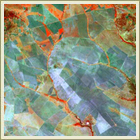 |
Satellites as Farmers' Helpers
Satellites can play an important role in measuring agricultural productivity, ranging from real-time forecasting of production to
long-term study of why some fields yield more than others. Using them successfully to monitor large areas, however, is difficult
because many methods rely on local field measurements for calibration. A study co-authored by Senior Fellow David Lobell
(Earth Sciences, FSI) tested several approaches using satellites that do not rely on ground calibration to examine detailed field
measurements of yields in more than 200 Nebraska cornfields. The researchers determined that one of the computationally fastest
methods was also one of the best. The results will inform the development of an automated yield mapping system based solely on free,
public satellite and weather data.
Photo credit: USGS
Read more...
"Testing Remote Sensing Approaches for Assessing Yield Variability Among Maize Fields," Agronomy Journal, Oct. 18, 2013 |
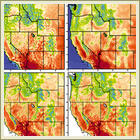 |
Understanding Climate Better
A study co-authored by Senior Fellow Noah Diffenbaugh (Earth Sciences) evaluated the potential viability of "ultra-high-resolution" computational climate models. Because of limited computing resources, climate model experiments have been confined to low grid
resolutions that are too coarse to explicitly resolve convection, the movement of fluid molecules, in the atmosphere. However, new
computing resources are presenting the possibility of "nonhydrostatic" climate simulations that do resolve convection. The
researchers ran various simulations using the 2010 summer climate of 11 western states as a case study. Results showed that the
nonhydrostatic simulations more accurately portray a variety of conditions such as surface temperature, precipitation and wind speed
features associated with the complex terrain of the region. The researchers suggest that further development of nonhydrostatic
approaches is likely to yield important insights into how local-scale climate phenomena respond to increases in global greenhouse gas
concentrations.
Read more...
"Nonhydrostatic Nested Climate Modeling: A Case Study of the 2010 Summer Season Over the Western United States," Journal of Geophysical Research: Atmospheres, Oct. 16, 2013 |
| |
Other Climate Change Research
"The Benefits of Recent Warming for
Maize Production in High Latitude China," Climatic Change, January 2014, co-authored by Senior Fellow David Lobell (Earth Sciences, FSI)
|
| |
More
information about Stanford Woods Institute climate research |
| |
 |
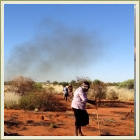 |
Hunting Practice Has Surprising Result
The way that Aboriginal people in Australia hunt monitor lizards for food increases the lizard population, according to a study co-authored by Woods-affiliated Associate Professor of Anthropology Rebecca Bird and Senior Research Scientist Doug Bird. The hunting method - using fire to clear patches of land to improve the search for game - also creates a
mosaic of regrowth that enhances habitat. The findings offer new insight into maintaining animal communities through ecosystem
engineering and co-evolution of animals and humans.
Photo credit: Rebecca Bird
Read more and watch video...
"Niche Construction and Dreaming Logic: Aboriginal Patch Mosaic Burning and Varanid Lizards (Varanus gouldii) in
Australia," Proceedings of the Royal Society B, Oct. 23, 2013 |
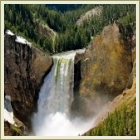 |
Scientists Making Good Use of Your Vacation Photos
In an attempt to learn more about the value of parks and other natural areas, scientists affiliated with the Natural Capital Project, including academic researcher Anne Guerry, are using photo-sharing site Flickr to measure where and when people use specific
sites for recreation and tourism. Their findings promise a new way to measure the benefits and value that these places provide to the economy and society as a whole.
Photo credit: Jess Gunn
Read more...
"Using Social Media to Quantify Nature-Based Tourism and Recreation," Scientific Reports, Oct. 17, 2013 |
| |
Other Ecosystem Services and Conservation Research
"Detecting Pest Control Services
Across Spatial and Temporal Scales, Agriculture," Ecosystems & Environment, Volume, Dec. 1, 2013, co-authored
by research associate Rebecca Chaplin-Kramer (Natural Capital Project)
"Water Stress
Strengthens Mutualism Among Ants, Trees and Scale Insects," PLOS Biology, Nov. 5, 2013, co-authored by Senior Fellow Rodolfo Dirzo and Woods-affiliated Biology Professor Deborah Gordon
"Climate Change's Impact on Key Ecosystem
Services and the Human Well-Being They Support in the U.S.," Frontiers in Ecology and the Environment, November
2013, co-authored by Consulting Professor Mary Ruckelshaus, managing director of the Natural Capital Project and postdoctoral scholar Katie Arkema (Natural Capital Project)
"Climate Change Impacts on Ecological Systems:
Introduction to a U.S. Assessment," Frontiers in Ecology and the Environment, November 2013, co-authored by
Consulting Professor Mary Ruckelshaus,
managing director of the Natural Capital Project
"Pacific Islands in the Anthropocene," Elementa, November 2013, co-authored by Senior Fellow Peter Vitousek (Biology)
"Humans and Nature: How Knowing and Experiencing Nature Affect Well-Being," Annual Review of Environment and Resources, October 2013, co-authored by academic researcher Anne Guerry (Natural Capital Project) and Woods-affiliated postdoctoral scholar Rachelle K. Gould (Education)
|
| |
More information about Stanford Woods Institute ecosystem services research |
| |
 |
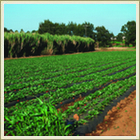 |
Soil Shapes Society
What role does soil play in determining the story of a people? Researchers working in Hawaii, including Senior Fellow Peter Vitousek (Biology), analyzed soils of differing ages, mineral content and
rainfall exposure, among other properties. Their findings suggest that the potential for developing large, intensive rain-fed agricultural systems – and the social and cultural features that
accompanied them – was tied to the distribution of younger soil affected by weathering and biological uplift of nutrients.
Soils in this domain likely also supplied high levels of nutrients to the forests that occupied the sites before Hawaiian cultivation
and the ranches that occupy the land now.
Photo credit: NRCS
Read more...
"Pedogenic Thresholds and Soil Process Domains in Basalt-Derived Soils," Ecosystems, December 2013 |
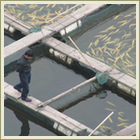 |
The Future of Seafood
When it comes to global aquaculture, China is the big fish. Its massive production of carp and tilapia and its demand for fish
meal threaten wild forage fisheries. These issues promise to grow as demand increases along with income levels and urbanization.
Researchers, including Senior Fellow Rosamond Naylor (Earth Sciences, FSI), used survey data from three Chinese provinces to assess how future demand for fish meal will likely be
affected by the country's shifting patterns of seafood consumption and production. Two conclusions of their study: Chinese fish farmers are using feed inefficiently due to polyculture practices,
and government statistics underestimate household demand for fish by up to 35 percent because they do not account for out-of-home
consumption.
Photo credit: IvanWalsh.com
Read more...
"Feed and Fishmeal Use in the Production of Carp and Tilapia in China," Aquaculture, Nov. 15, 2013 |
| |
More information about Stanford Woods Institute food security research |
| |
 |
 |
A Natural Water Saver
In the arid Southwest, water managers and planners are reassessing the role of riparian vegetation in water loss. Researchers
working in the flood plain of the Rio Grande, north of Caballo Lake, New Mexico, determined the water savings that could be achieved
by replacing invasive species with salt grass for use in irrigation management and urban settings. The study, co-authored by Senior Fellow Richard Luthy (Civil and Environmental Engineering), found that native salt grass has the potential to save about two acre-feet per
year, compared to invasive salt cedar, while also rehabilitating natural riparian habitat.
Photo credit: lan Gross
Read more...
"Assessment of the Crop Coefficient for Saltgrass Under Native Riparian Field Conditions in the Desert Southwest," Hydrological Processes, Dec. 2, 2013 |
 |
A Promising Path in Contaminant Sequestration
In a study of sediments contaminated with petroleum
and polychlorinated biphenyls, researchers, including Senior Fellow Richard Luthy (Civil and Environmental Engineering), studied the effectiveness of activated carbon (AC) treatment to sequester contaminants.
Their findings verify that AC treatment can effectively control the spread of the contaminants within a reasonable time frame. This
in-place treatment, the researchers point out, avoids the need for dredging or capping.
Photo credit: NOAA
Read more...
"In-Situ Sequestration of Hydrophobic Organic Contaminants in Sediments Under Stagnant Contact With Activated Carbon: 1.
Column Studies," Environmental Science & Technology, Oct. 1, 2013 |
| |
More information about Stanford Woods Institute freshwater research |
| |
 |
 |
Managing Marine Resources in a New Way
Pollution from agricultural runoff, species collapse from overfishing and other human-caused stressors interact in complex ways to
affect marine ecosystems. While we may understand individual impacts, we lack assessments of cumulative impacts on ecologically and
economically key components of ocean ecosystems. Researchers, including Senior Fellows Larry Crowder (Biology) and Barbara Block (Biology) and Woods-affiliated postdoctoral scholar Sara Maxwell (Biology), developed a way to measure cumulative utilization and
impact (CUI) by combining data from electronic tracking devices on marine predators with data on 24 human-caused stressors. Their findings show significant variations in CUI, with some of the highest
impacts within federal marine sanctuaries. As a result, the researchers suggest that marine resource managers use comprehensive
approaches that account for both cumulative human impacts and trade-offs among multiple stressors.
Photo credit: Dan Costa
Read more...
"Cumulative Human Impacts on Marine Predators," Nature Communications, Oct. 28, 201 |
 |
Better Ocean Ecosystem Management
An ecosystem protection plan that works today may not work tomorrow. A study co-authored by Woods-affiliated Professor of Biological Sciences Fiorenza Micheli evaluated long-term variation in rocky reef communities in Italy's Tigullio Gulf, an
emblematic case study where various conservation measures have been implemented to manage multiple human uses. They found that
natural communities subject to certain conservation measures, especially within a marine protected area, were significantly damaged
by human activity elsewhere. The results suggest that establishing protected areas alone is insufficient. Instead, ecosystem
management should consider human interactions and conduct continuous monitoring.
Photo credit: Carlo Nike Bianchi
Read more...
"Conserving Biodiversity in a Human-Dominated World: Degradation of Marine Sessile Communities Within a Protected Area With Conflicting Human Uses," PLOS ONE, Oct. 15, 2013 |
| |
Other Oceans Research
"Predicting Bycatch Hotspots for Endangered
Leatherback Turtles on Longlines in the Pacific Ocean," Proceedings of the Royal Society B, Jan. 8, 2014, co-
authored by Senior Fellow Barbara Block
(Biology)
"Cumulative Human
Impacts on Mediterranean and Black Sea Marine Ecosystems: Assessing Current Pressures and Opportunities," PLOS ONE,
Dec. 4, 2013, co-authored by Woods-affiliated Professor of Biological Sciences Fiorenza Micheli
The Effects of Intermittent Exposure to Low pH and Oxygen Conditions on Survival and Growth of Juvenile Red Abalone," Biogeosciences, Nov. 13, 2013, co-authored by Woods-affiliated Professor of Biological Sciences Fiorenza Micheli
"Drag Coefficients for Single Coral Colonies and Related Spherical Objects," Limnology and Oceanography: Fluids and Environments, Nov. 5, 2013, co-authored by Senior Fellow Stephen Monismith (Civil and Environmental Engineering)
|
| |
More information about Stanford Woods Institute oceans research |
| |
 |
 |
Neighborly Transaction as Health Solution
In sub-Saharan Africa, only a third of urban dwellers have access to a piped water connection in their homes. Other sources, such
as public standpipes, are often plagued by poor maintenance, heavy use and high cost due to the need for attendants and other
factors. As a result, about one in five people purchases water from neighbors connected to public or private utility lines. This
practice, known as resale, is either illegal or informal in many places. A recent study by researchers, including Senior Fellow Jenna Davis (Civil and Environmental Engineering), challenges the logic of discouraging resale.
Photo credit: Valentina Zuin
Read more...
"The Entrepreneurship Myth in Small-Scale Service Provision: Water Resale in Maputo, Mozambique," Journal of Water,
Sanitation and Hygiene for Development, Oct. 21, 2013 |
 |
Reducing Risk From Indoor Air
In the developing world, the act of cooking can be deadly. Exposure to indoor biomass smoke from cookstoves and other sources has
been consistently associated with an increased risk of acute lower respiratory infections (ALRI) in young children, but the nature of
this relationship is not well understood. In Bangladesh, where approximately half of all children under 2 years of age suffer from
ALRI each year, researchers, including Senior Fellow Stephen Luby (Medicine, FSI), looked at the effect of indoor exposure to particulate matter on the incidence of ALRI among children in a low-income,
urban community. Results of the study suggest
that reducing indoor particulate exposure, by decreasing reliance on biomass for cooking, could decrease the frequency of ALRI among
infants, the children at highest risk of death from these infections.
Read more...
"Indoor Exposure to Particulate Matter in the Incidence of Acute Lower Respiratory Infections Among Children: A Birth Cohort
in Study Urban Bangladesh," Indoor Air, October 23, 2013 |
| |
Other Public Health Research
"Enteric Pathogens
in Stored Drinking Water and on Caregiver's Hands in Tanzanian Households With and Without Reported Cases of Child Diarrhea," PLOS ONE, January 2014, co-authored by Woods-affiliated Associate Professor of Structural Engineering Alexandria Boehm, Senior Fellow Jenna Davis (Civil and Environmental Engineering) and Research Associate Amy Pickering
"Risk Practices for
Animal and Human Anthrax in Bangladesh: An Exploratory Study," Infection Ecology and Epidemiology, Nov. 27, 2013,
co-authored by Senior Fellow Stephen Luby
(Medicine, FSI)
Water Research special issue on
microbial source tracking, Nov. 15, 2013, eight studies co-authored by Woods-affiliated Associate Professor of Structural
Engineering Alexandria Boehm
|
| |
More information about Stanford Woods Institute public health research |
| |
 |
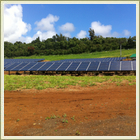 |
Marginal Lands as Prime Real Estate for Energy
A study co-authored by Senior Fellow Chris Field (Biology, Earth Sciences, FSI) identifies several marginal land
categories suitable for renewable energy development, representing about 11 percent of the U.S. mainland. The study finds that a
significant potential exists for renewable energy development in areas that are generally underused, difficult to cultivate, have low
economic value and varied developmental potential. The researchers assessed a variety of technologies and found that solar
technologies present the highest opportunity, followed by wind and biomass power. The findings include estimates of the amount of
renewable electricity that could be produced on marginal lands.
Photo credit: NREL
Read more...
"Renewable Energy Potential on Marginal Lands in the United States," Renewable and Sustainable Energy Reviews, January 2014 |
 |
Harmonizing Conservation and Development
The goal of sustainability science is to understand how biological conservation and socioeconomic development can be harmonized. In a case study, researchers including Woods-affiliated Professor of Biological Sciences Fiorenza Micheli looked at a Mediterranean Sea marine protected area (MPA)
that is thriving despite intense pressure from fishing, tourism and coastal development. The study shows that the MPA's success is a
product of leadership and knowledge that devised and implemented an effective strategy, with the support and participation of key
actors. These insights could help inform the management of other MPA systems facing extensive human pressures.
Photo credit: Carlo Nike Bianchi
Read more...
"Achieving Success Under Pressure in the Conservation of Intensely Used Coastal Areas," Ecology and Society, Oct. 31, 2013 |
| |
More information about Stanford Woods Institute sustainable development research |
| |
|
|
| |
Find Us on the Web
   |
|
The Stanford Woods Institute Research Digest is a quarterly report of findings by Woods fellows and affiliated faculty, as well as fellows with the Institute's Leopold Leadership Program. Current and past issues are online.
Contact us to subscribe or provide information about new and forthcoming research.
To learn more about the Stanford Woods Institute for the Environment, visit our website or email us.
Stanford Woods Institute for the Environment
Jerry Yang & Akiko Yamazaki Environment & Energy Building - MC 4205
473 Via Ortega
Stanford, CA 94305 |
|
|
|
